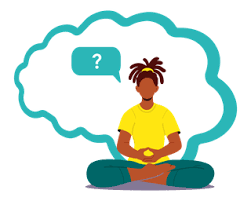In our fast-paced world, finding moments of peace and tranquility can seem elusive. Meditation offers a powerful tool to cultivate inner calm and improve overall well-being. While it might seem daunting for beginners, meditation is a practice accessible to everyone. This guide will introduce you to the basics of meditation and provide simple techniques to get you started.

Understanding Meditation: More Than Just Sitting Still
Meditation is often misunderstood as simply sitting quietly with your eyes closed. While this is a common practice, meditation encompasses a broader spectrum of techniques aimed at focusing the mind and increasing awareness. It’s about training your attention to bring it back to the present moment, again and again.
Simple Meditation Techniques for Beginners
Here are some beginner-friendly meditation techniques to explore:
- Focused Attention Meditation: This involves directing your attention to a single point of focus, such as your breath, a mantra, or a specific body sensation.
- Mindfulness Meditation: This technique encourages observing your thoughts and feelings without judgment. It’s about being present in the moment and accepting your experiences as they are.
- Body Scan Meditation: This involves bringing your attention to different parts of your body, noticing any sensations without judgment.
- Loving-Kindness Meditation: This practice focuses on cultivating feelings of kindness and compassion towards yourself and others.
Creating a Meditation Practice
To establish a consistent meditation practice, consider the following tips:
- Find a Quiet Space: Choose a place where you won’t be disturbed.
- Start Small: Begin with short meditation sessions, gradually increasing the time as you become more comfortable.
- Be Patient: Meditation is a skill that takes time to develop. Don’t get discouraged if your mind wanders initially.
- Experiment with Different Techniques: Try different meditation styles to find what resonates best with you.
- Consistency is Key: Regular practice is essential for reaping the benefits of meditation.
Incorporating Meditation into Daily Life
Meditation doesn’t have to be confined to a formal sitting practice. Here are some ways to incorporate mindfulness into your daily life:
- Mindful Breathing: Take a few moments throughout the day to focus on your breath.
- Mindful Walking: Pay attention to the sensations of walking and the environment around you.
- Mindful Eating: Practice mindful eating by focusing on the taste, texture, and smell of your food.
- Mindful Listening: Give your full attention to the person you’re speaking with.
Remember, the goal of meditation isn’t to eliminate thoughts but to observe them without judgment. With consistent practice, you’ll begin to notice positive changes in your mental and emotional well-being.
Would you like to explore specific meditation techniques in more detail or discuss how to overcome common challenges beginners face?
Meditation to Lessen Stress
While all these changes can help, there is one thing that is more powerful than any other tool when it comes to combating stress: meditation.
Meditation is something a lot of people don’t fully understand. There is the assumption among some that meditation is somehow ‘mystical’ or that it is necessarily linked with religion. Neither of these things is true.
There are many different types of meditation from transcendental, to mindfulness, to religious meditation but all of them really just have one thing in common: they involve the purposeful direction of attention inward.
Whether it is reflecting on your own thoughts, praying or just sitting silently and trying to clear your mind, meditation involves making the conscious decision to take control of what you’re thinking and to try and stop your thoughts from jumping around everywhere. And when you do this, you will find it has a truly profound effect on your ability to stay calm in stressful situations, to control the nature of your thoughts and to combat many of the negative effects of stress.
In fact, studies show us that meditation can improve the areas of your brain that stress destroys – actually increasing the amount of grey matter in the brain and the amount of whole-brain connectivity. Furthermore, it can help to improve areas of the brain specifically related to motivation, attention and willpower. One study shows that it only takes 8 weeks to see amazing positive changes to the brain and restoration of grey matter in particular.
People who use meditation will usually report that they feel generally calmer, happier and more at peace throughout the day. This results in a better mood, heightened attention and general improvements in cognitive function and productivity.
All these things mean that meditation is actually the perfect antidote to stress and can undo a lot of the damage that meditation causes. Apart from anything else, meditation will help you to take a small break from the constant stress of daily life and from the racing thoughts that come with this. More to the point though, it will teach you to take control of racing thoughts at will and simply to put them to one side.
Meanwhile, allowing your brain some time to enjoy this highly relaxed state will encourage the reparation of neurons and the cementing of things you’ve learned through the day.
Finally, it makes sense that areas controlling self-control would develop during the process of meditation. Meditation uses certain brain areas and we now know that the more you use an area of the brain, the more it grows. This works just like using a muscle and is a process known as ‘brain plasticity’.
And by practicing reflecting on your own mental state and being more aware of your own emotions, it only follows that you would better be able to control it and to avoid letting stress or impulse get the better of you in future.
How to Get Started With Meditation
So this is what meditation does for you and why it is the ideal antidote to stress.
The next question is how can you get started with meditation? Do you need to attend a class? Do you need to be a Buddhist monk?
Fortunately, meditation is actually pretty simple and this is what ends up making it hard even in some cases. A lot of people who first try meditation feel that it is <em>too </em>simple and thus assume they must be doing something wrong!
The easiest way to get started if you’re a complete beginner, is to try guided meditation. Guided meditation means using a pre-recorded script that will talk you through everything you need to be doing at any given stage. Essentially, this works to help direct your attention and show you what you need to be reflecting on or paying attention to at any given time.
A good one to try is ‘Headspace’. This is available as a website and as an app and in either case, you’ll find a selection of guided meditations to walk you through. The only downside is that headspace is not free and that after the first 10 sessions, you’ll have to start paying.
Fortunately, those first ten sessions are more than enough to give you a taste of meditation and to teach you the basics. From here, you’ll then be able to take what you learned and re-apply it in order to continue on your own.
If you’d rather not start a paid system though, then you can always use one of the <em>many </em>free YouTube videos that will do the same thing!
In general, most guided meditation will take you through the following steps.
To start with, you will sit somewhere comfortable and close your eyes. Set a timer for 10 minutes, or however long you have until you need to be doing other things. While you should be comfortable, you shouldn’t be too reclined or generally put yourself in danger of falling asleep!
The next thing to do, is to bring your attention to the sounds and the world around you. This means just listening to the sounds and noticing what you can hear. This is an interesting exercise in and of itself: if you actually stop to listen you’ll be able to pick up on a <em>lot </em>more information than you were probably previously aware of.
Don’t strain to listen but instead just let the sounds come to you – whether those be barks from dogs next door, the sound of birds or perhaps chatter from someone in another building that you can hear through the walls.
After you have done this for a little while, the next step is to bring your attention in to yourself and to notice how your body feels. This means noticing the way that your weight is distributed on your buttocks. Is it evenly distributed? Are you leaning slightly to one side? Likewise, try to notice the air against your skin, the temperature, any aches and pains etc.
You can then try the ‘body scan’. This is something that some people use as the main basis for their meditation and it involves focussing on each part of your own body, starting right from the head and then moving down the body slowly from the face, to the chest, to the legs, to the feet. Each time you get to a point on your body, make a conscious effort to release any tension you might be holding there and to relax.
You can even turn your attention inward further by seeing if you can feel the beating of your own heart, or the movement of your diaphragm.
Either way, we’re now going to focus on breathing. This is something that a lot of people will again use as the entire basis of their meditation. Simply count the breaths in and the breaths out and each time you get to ten, start again. The aim now is to have all of your focus and all of your attention on the breathing and not to be distracted by anything outside.
Now, from time to time, you will notice that your thoughts start to drift and that you end up thinking about other things. This is a fantastic example of just how hard we find it to focus on any one thing for a given period of time. It’s a fantastic example of just why you <em>need </em>this meditation!
Don’t fret when it happens though. This is the worst thing you can do! Instead, simply ‘notice’ that your mind has wandered and then bring your attention <em>back </em>to your breathing again. Each time it drifts off, just re-center and don’t worry about it.
Focussing on the breathing is simply giving us a way to center our thoughts and to remove the distractions that normally interrupt. This could just as easily work by focusing on anything else: for example, some people will focus on a single word called a ‘mantra’. A mantra is what is often used in transcendental meditation for instance and might mean just repeating the word ‘Om’ in order to busy your internal monologue.
Finally, the last stage of our guided meditation is going to be to just let the thoughts wander freely and to let them go wherever they want to.
This last stage is essentially mindfulness meditation. The idea is that you’re going to detach yourself from those thoughts and simply ‘watch them’ rather than feeling emotionally affected by them.
This last part is the part where you get to really relax and stop ‘fighting’ your brain and it’s a great way to end. Then bring your focus back to your breathing, then back to your body, back to the world around you and eventually open your eyes.
Discover more from Personal Blog of Richard Tong
Subscribe to get the latest posts sent to your email.





Great article. I will be dealing with a few of these issues as well..
It’s hard to come by educated people on this topic, but you seem like you know what you’re talking about! Thanks
Hello.This post was extremely motivating, especially since I was looking for thoughts on this issue last Tuesday.
Woah! I’m really digging the template/theme of this site. It’s simple, yet effective. A lot of times it’s challenging to get that “perfect balance” between superb usability and visual appeal. I must say that you’ve done a superb job with this. Also, the blog loads super fast for me on Safari. Exceptional Blog!
You can certainly see your skills in the work you write. The world hopes for even more passionate writers like you who aren’t afraid to say how they believe. Always follow your heart.
I visited a lot of website but I believe this one contains something extra in it in it
Good day! Do you know if they make any plugins to safeguard against hackers? I’m kinda paranoid about losing everything I’ve worked hard on. Any suggestions?
This blog post is beautifully articulated. Thanks for sharing your valuable perspective!
Your content is always spot on, and this post is no different. Thank you!
Grateful doesn’t even begin to describe how we feel about having you here. You make a difference to us.
We are so thankful to have such thoughtful readers like you. Your interest is what motivates this blog!
Thank you for spending your time with our content. Your engagement makes everything we do so worthwhile!
We deeply cherish your trust, which inspires our journey toward better achievements. Thank you!